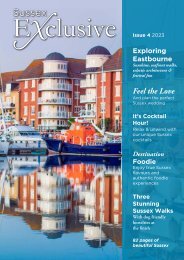Sussex Exclusive Magazine Edition II 2022
Bringing you the best of Sussex, from discovering Sussex vineyards to exploring Lewes and savouring Sussex foodie experiences. In this edition, we meet local artists, learn about Sussex folklore and legends, bring you mouth-watering recipes, mini break ideas, share wellbeing tips and advice, and more. Grab a coffee, put your feet up and please enjoy.
Bringing you the best of Sussex, from discovering Sussex vineyards to exploring Lewes and savouring Sussex foodie experiences. In this edition, we meet local artists, learn about Sussex folklore and legends, bring you mouth-watering recipes, mini break ideas, share wellbeing tips and advice, and more. Grab a coffee, put your feet up and please enjoy.
You also want an ePaper? Increase the reach of your titles
YUMPU automatically turns print PDFs into web optimized ePapers that Google loves.
Spotlight<br />
on<br />
Lewes<br />
Explore this historic market town that has bustled<br />
with life since Anglo Saxon times<br />
Lewes has a long, interesting and at<br />
times distinguished past, making it a<br />
delight to visit for anyone with even<br />
a passing interest in history. But it’s<br />
equally a great spot for those that<br />
love quirky flea markets, craft beer, beautiful<br />
countryside or a splash of culture.<br />
A look back<br />
The first evidence of life near Lewes dates back<br />
to the Iron Age and a hill-fort built on nearby<br />
Mount Caburn, a steep hill that overlooks the<br />
town. The Romans were here too with a villa at<br />
the foot of Mount Caburn.<br />
Lewes has the ultimate strategic position, based<br />
as it is on the River Ouse and in a small gap in<br />
the South Downs. As a result, it’s thought Lewes<br />
began to grow as an Anglo Saxon settlement from<br />
the 6th century onwards. Certainly, by the reign<br />
of King Alfred (the Great), the town had been<br />
fortified in response to Viking raids, and by the<br />
Norman invasion it was a thriving settlement.<br />
Following the Battle of Hastings, William the<br />
Conqueror granted William de Warenne the<br />
Rape of Lewes and he in turn built Lewes Castle<br />
and cemented the town’s place in <strong>Sussex</strong> history.<br />
In 1264, the castle and town were the site of the<br />
infamous Battle of Lewes, during which Henry<br />
<strong>II</strong>I was defeated by Simon de Montfort, 6th Earl<br />
of Leicester, and his army of rebel barons.<br />
The castle itself passed to the ownership of the<br />
Earl of Arundel in 1347 and after 300 years, this<br />
marked the beginning of the demise of the castle<br />
as somewhere of significant importance.<br />
But that’s not to say the town hasn’t featured<br />
in <strong>Sussex</strong> history since. Between 1555–1557,<br />
Lewes was the site of the execution of 17<br />
Protestant martyrs, and during the Civil War<br />
it was a Parliamentarian stronghold. From the<br />
mid-18th century, the town gradually prospered<br />
again and developed textiles, iron, brewing, and<br />
ship-building industries. Today, Lewes remains<br />
a bustling market town with dozens of historic<br />
buildings and landmarks as a testament to its<br />
long past.<br />
52 | sussexexclusive.com











